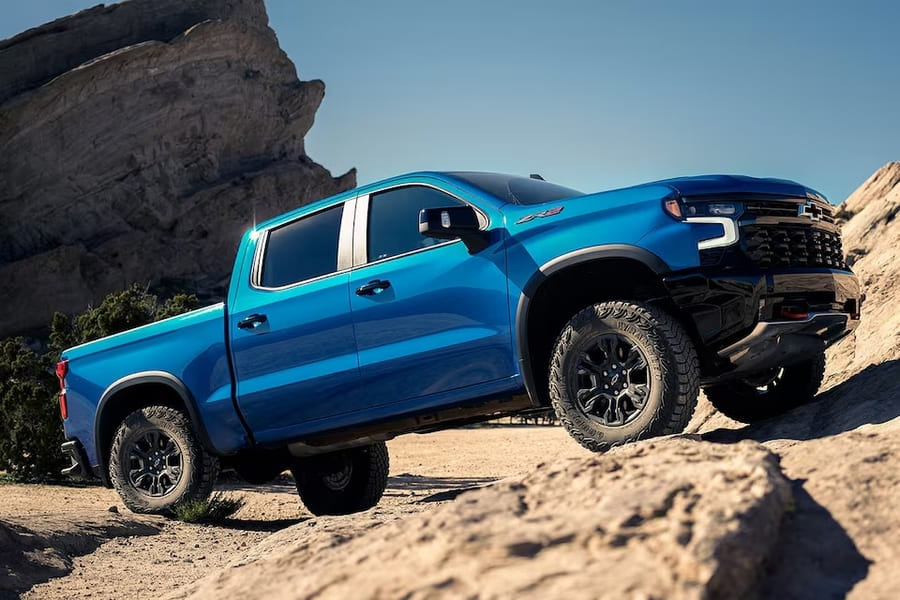Cooling System Maintenance: Silverado 1500 Gas vs Diesel
The Chevrolet Silverado 1500, available in gasoline and diesel variants, is a popular choice for truck enthusiasts and professionals alike. One crucial aspect of maintaining these powerful vehicles is proper care of the cooling system. While both engine types rely on efficient cooling to operate optimally, there are significant differences in how their cooling systems […]
The Chevrolet Silverado 1500, available in gasoline and diesel variants, is a popular choice for truck enthusiasts and professionals alike. One crucial aspect of maintaining these powerful vehicles is proper care of the cooling system. While both engine types rely on efficient cooling to operate optimally, there are significant differences in how their cooling systems function and the maintenance they require.

The Basics of Cooling Systems
Before getting into the specifics of gas and diesel engines, it’s essential to understand the fundamental components and functions of a vehicle’s cooling system:
- Radiator: The primary heat exchanger that dissipates heat from the coolant to the air.
- Water Pump: Circulates coolant through the engine and radiator.
- Thermostat: Regulates the flow of coolant to maintain optimal engine temperature.
- Coolant: The fluid that absorbs and transfers heat from the engine.
- Hoses: Transport coolant between the engine, radiator, and other components.
- Cooling Fans: Help draw air through the radiator to enhance cooling.
Both gas and diesel engines in the Silverado 1500 use these components, but their specific designs and maintenance needs can differ significantly.
Gasoline Silverado 1500 Cooling System Maintenance
Coolant Type and Capacity
The gasoline Silverado 1500 typically uses a long-life coolant, often called Dex-Cool or equivalent. The cooling system capacity varies depending on the specific engine but generally ranges from 12 to 15 liters.
Coolant Change Interval
For most gasoline Silverado 1500 models, the coolant change interval is quite long:
- Initial change: 240,000 kilometers or 5 years, whichever comes first
- Subsequent changes: Every 150,000 kilometers or 5 years, whichever comes first
However, regularly checking the coolant level and condition is crucial, as operating conditions can affect coolant life.
Thermostat Operation
The Silverado gasoline thermostat typically begins to open at around 82°C (180°F) and is fully open at about 95°C (203°F), allowing the engine to reach optimal operating temperature quickly and maintain it efficiently.
Radiator Maintenance
The radiator in a gasoline Silverado 1500 should be inspected regularly for debris or damage. Cleaning the radiator fins annually can help maintain optimal cooling efficiency. Look for signs of corrosion or leaks during these inspections.
Water Pump Considerations
The serpentine belt typically drives the water pump in gasoline engines. While it doesn’t have a specified replacement interval, you should inspect it for signs of wear or leakage during routine maintenance.
Diesel Silverado 1500 Cooling System Maintenance
Coolant Type and Capacity
Diesel Silverado 1500 models often use a different type of coolant than their gasoline counterparts. It’s typically a nitrite-free, organic acid technology (OAT) coolant specific for diesel engines. The system capacity is generally larger, ranging from 15 to 18 liters.
Coolant Change Interval
Diesel engines often have more frequent coolant change intervals due to the higher stress placed on the cooling system:
- Initial change: 160,000 kilometers or 5 years, whichever comes first
- Subsequent changes: Every 100,000 kilometers or 5 years, whichever comes first
As with gasoline engines, regular checks of coolant level and condition are crucial.
Thermostat Operation
Diesel engines in the Silverado 1500 typically operate at higher temperatures than gasoline engines. The thermostat may begin to open at around 88°C (190°F) and be fully open at about 98°C (208°F). This higher operating temperature contributes to the diesel engine’s efficiency.
Radiator Maintenance
Diesel Silverado 1500 models often have larger, more robust radiators to handle the increased heat load. Regular cleaning is even more critical for diesel models, as they often see more heavy-duty use. Inspect for signs of oil contamination in the coolant, which could indicate a problem with the oil cooler.
Water Pump Considerations
In many diesel Silverado 1500 models, the water pump is gear-driven rather than belt-driven. While this generally makes it more durable, replacing it can be more complex if necessary. Regular inspections for leaks or unusual noises are important.
Additional Cooling System Components in Diesel Models
Diesel Silverado 1500 models often have additional cooling system components not found in their gasoline counterparts:
Intercooler
Diesel engines are often turbocharged and include an intercooler to cool the compressed air before it enters the engine. While not part of the main cooling system, the intercooler plays a crucial role in engine efficiency and performance. Regular inspection and cleaning of the intercooler can help maintain optimal performance.
Oil Cooler
Diesel engines typically include an oil cooler as part of the cooling system, helping to maintain proper oil temperature under heavy loads. Inspecting for leaks and ensuring proper coolant flow through the oil cooler is essential to diesel cooling system maintenance.
Cooling System Maintenance Best Practices
Regardless of whether you have a gasoline or diesel Silverado 1500, some maintenance practices are universal:
- Regular Inspections: Check coolant levels and hose condition, and look for any signs of leaks at least monthly.
- Pressure Testing: Annual pressure testing of the cooling system can help identify weak points before they lead to failures.
- Coolant Condition: Use test strips or a refractometer to check the coolant’s pH and freeze protection annually.
- Flushing: When changing coolant, perform a thorough system flush to remove any built-up deposits or contaminants.
- Use the Right Coolant: Always use the manufacturer-recommended coolant type. Mixing different types can lead to reduced cooling efficiency or even system damage.
- Address Issues Promptly: If you notice temperature fluctuations, coolant loss, or other cooling system issues, address them immediately to prevent more serious problems.
Impact of Driving Conditions on Cooling System Maintenance
The maintenance needs of your Silverado 1500 cooling system, whether gas or diesel, can be significantly affected by how and where you drive:
Towing and Heavy Loads
Both gas and diesel models will see increased stress on their cooling systems when towing or carrying heavy loads. If you frequently use your Silverado 1500 for these tasks:
- Check coolant levels more frequently
- Consider more frequent coolant changes
- Pay extra attention to the condition of the hoses and the radiator
- For diesel models, monitor the intercooler and oil cooler more closely
Extreme Temperatures
In very hot climates or during summer months:
- Check coolant levels more often, as higher temperatures can lead to more rapid coolant loss
- Ensure the cooling fans are functioning properly
- Consider using a coolant with a higher boiling point
In very cold climates:
- Ensure the coolant provides adequate freeze protection
- Check the thermostat operation, as a stuck-open thermostat can prevent the engine from reaching optimal operating temperature
Dusty or Off-Road Conditions
If you frequently drive your Silverado 1500 in dusty conditions or off-road:
- Clean the radiator and intercooler (for diesel models) more frequently to remove built-up debris
- Check the coolant more often for contamination
- Consider using a more heavy-duty coolant filter, if applicable
Cooling System Troubleshooting
Understanding common cooling system issues can help you identify problems early:
- Overheating: Can be caused by low coolant levels, a malfunctioning thermostat, a failing water pump, or a clogged radiator.
- Coolant Loss: May indicate a leak in the system. Check hoses, the radiator, and gaskets for signs of leakage.
- White Exhaust Smoke: In both gas and diesel engines, this can indicate coolant leaking into the combustion chambers, possibly due to a blown head gasket.
- Sweet Smell: The smell of coolant (often described as sweet) can indicate a leak in the system.
- Temperature Fluctuations: Rapid changes in temperature gauge readings can indicate a failing thermostat or air in the cooling system.
Long-Term Benefits of Proper Cooling System Maintenance
Maintaining the cooling system of your Silverado 1500, whether it’s gas or diesel, offers several long-term benefits:
- Engine Longevity: Proper cooling helps prevent premature wear on engine components.
- Fuel Efficiency: An engine operating at its optimal temperature will use fuel more efficiently.
- Performance: A well-maintained cooling system ensures the engine can perform at its best, especially under demanding conditions.
- Reliability: Regular maintenance helps prevent unexpected breakdowns due to cooling system failures.
- Resale Value: A well-maintained vehicle, including its cooling system, typically commands a higher resale value.
Tailored Care for Optimal Performance
While the basic principles of cooling system maintenance apply to gas and diesel Silverado 1500 models, understanding the specific needs of each engine type is crucial for optimal performance and longevity.
Gasoline Silverado 1500 models generally have simpler cooling systems with longer maintenance intervals, making them easier for the average owner to maintain. However, they may require more frequent attention if used for heavy-duty tasks.
Diesel Silverado 1500 models, with their additional cooling components and higher operating temperatures, require more specialized care and potentially more frequent maintenance. However, this additional care supports the diesel engine’s capability for high-torque, heavy-duty performance.
Regardless of your engine type, regular attention to the cooling system is a key part of vehicle maintenance. By understanding your vehicle’s specific needs and staying proactive with inspections and maintenance, you can ensure your pickup truck remains reliable, efficient, and capable of handling whatever tasks you throw its way.
Remember, while this guide provides a comprehensive overview, always refer to your vehicle’s owner’s manual for specific maintenance schedules and procedures. When in doubt, consult a certified Chevrolet technician who can provide expert advice tailored to your specific Silverado 1500 model and your unique driving needs.


